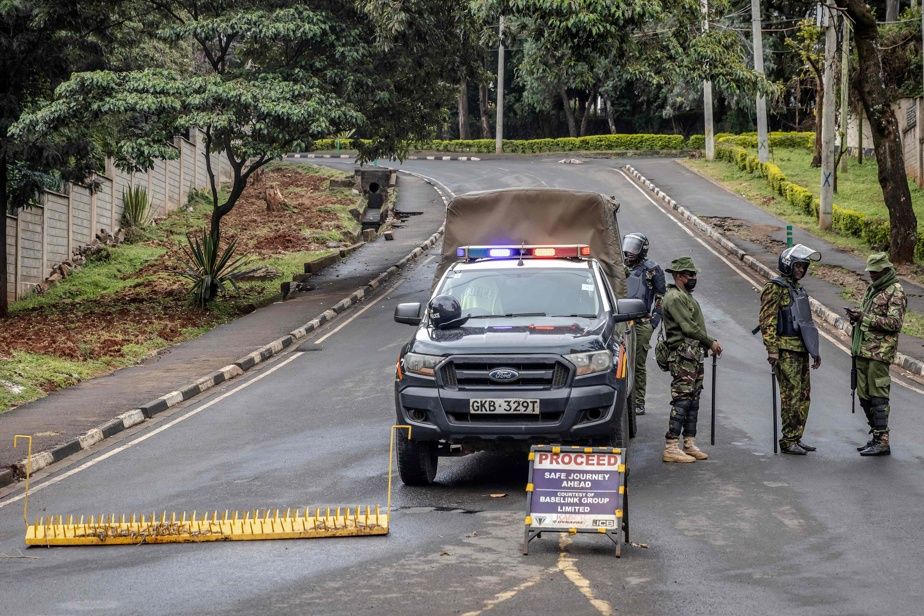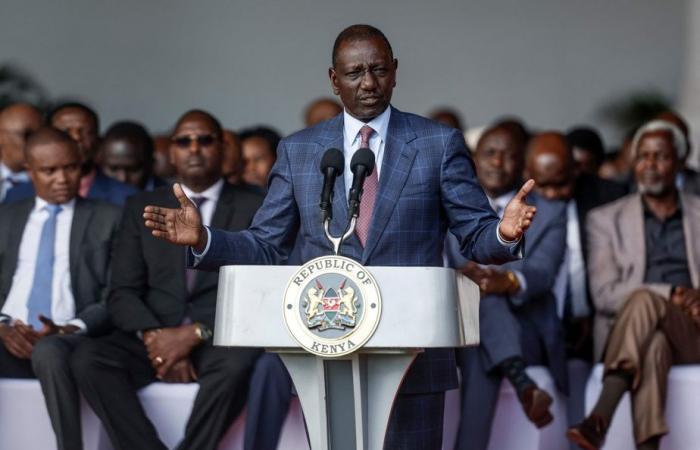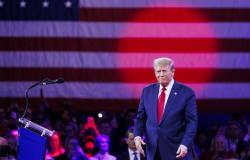(Nairobi) Kenyan police fired tear gas and rubber bullets on Thursday at small groups of demonstrators gathered again in Nairobi, two days after the deadly violence which led President William Ruto to withdraw his contested budget proposal.
Posted at 7:16 a.m.
Updated at 7:59 a.m.
Simon VALMARY
France Media Agency
A few scuffles broke out at midday between the police, deployed in large numbers in the streets of the city center of the capital, and these demonstrators who chanted in particular “Ruto must go” (Ruto must go).
These new demonstrations remained very fragmented at the beginning of the afternoon and a priori less massive than that of Tuesday, when thousands of demonstrators pushed back the police in the area of Nairobi’s official buildings.
PHOTO MONICAH MWANGI, REUTERS
Police officers arrested a protester in Nairobi, Kenya on June 27, 2024.
On Thursday, a few people threw stones at police officers, who responded with tear gas and rubber bullets, and at least seven people were arrested, AFP journalists noted.
Police in riot gear blocked access to roads leading to State House –– the presidential palace – and Parliament on Thursday.

PHOTO LUIS TATO, AGENCE FRANCE-PRESSE
Kenyan police officers stand in front of a roadblock making one of the roads leading to State House inaccessible, in Nairobi, June 27, 2024.
Demonstrations also took place in the opposition strongholds of Mombasa (east) and Kisumu (west).
Tuesday, after the first days of peaceful mobilization to demand the withdrawal of the new taxes planned by Mr. Ruto in his 2024-25 draft budget, the demonstration in Nairobi turned into a bloodbath, particularly around Parliament, including some buildings were burned and ransacked.
According to several NGOs, the police fired live ammunition to try to contain the crowd that forced the security barriers to enter the complex of the National Assembly and the Senate, an unprecedented attack in the history of the country, which has been independent since 1963.
A total of 22 people were killed during the day, including 19 in Nairobi, and more than 300 injured, the Kenyan human rights watchdog (KNHRC) said.
PHOTO MONICAH MWANGI, REUTERS
Police officers arrest a man during a protest in Nairobi, Kenya, June 27, 2024.
President Ruto announced the withdrawal of the proposed budget the next day, but this did not deter protesters from continuing to demonstrate on Thursday.
Beyond the draft budget, the protest movement has transformed into a broader denunciation of the policies of William Ruto, elected in 2022 with the promise of promoting redistribution to the working classes.
“Unfamiliar terrain”
Thursday morning, in the capital’s business center, where many businesses remained closed, Moe, employed in a perfumery, had lowered the curtain.
“Why did they have to kill these young people? This bill is not worth people dying for […] Some people are angry and might want revenge,” he laments in front of his perfume store, adding: “We are in unknown territory.”
On Wednesday, a figure in the protest movement, journalist and activist Hanifa Adan, called for demonstrations again on Thursday during a “peaceful” white march in memory of the victims.
A few hours later, William Ruto, who the day before had said he wanted to firmly repress “violence and anarchy”, finally announced the withdrawal of the draft budget, and said he wanted a national consultation with young people.

PHOTO SIMON MAINA, ARCHIVES AGENCE FRANCE-PRESSE
Kenya’s President William Ruto speaks to the media during a press conference at State House in Nairobi on June 26, 2024.
An announcement immediately described as a “communications operation” by Hanifa Adan, and greeted with suspicion by a number of demonstrators, like Lucky, 27, present in downtown Nairobi since 9 a.m. and who assures that he does not “trust Ruto, this law will pass one way or another.”
Debt
The spokesperson for UN Secretary General Antonio Guterres called on Wednesday for responsibilities to be “clearly” established after the deaths of the demonstrators.
The government considers new taxes necessary to give the heavily indebted country some room for maneuver.
PHOTO MONICAH MWANGI, REUTERS
A man during a protest in Nairobi, Kenya, June 27, 2024.
“How can we manage our debt situation together? asked William Ruto after capitulating on the draft budget.
He was particularly concerned about a significant hole in funding for programs for farmers and teachers.
The government “will now have to find a way to pacify two opposing forces: a population willing to resort to violence to protect its livelihoods, and a macroeconomic trajectory that, in the absence of considerable multilateral support, is heading toward the precipice,” according to an analysis by the Oxford Economics Institute.
The country’s public debt stands at about Sh10 trillion (C$104 billion), or about 70% of GDP. The 2024-25 budget had earmarked Sh4 trillion (C$42 billion) in spending, a record.









